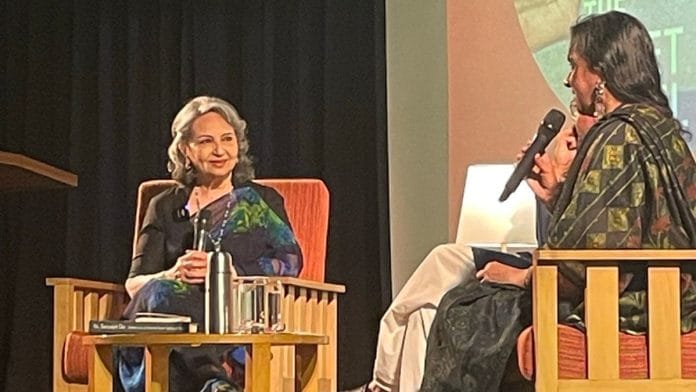New Delhi: On a recent evening in Delhi, Bollywood actor Sharmila Tagore was hosted in a packed house and described as a ‘quiet rebel’, an icon and a legend. The superstar refused to accept all these titles. She instead described her life as “normal”.
“It is very difficult to think of myself as an icon or a legend. These are vague words. I am a normal person with a normal life, with its anxieties and achievements,” said Tagore, elegantly dressed in a printed black saree, her white hair neatly styled.
The veteran actor was celebrated at the India International Centre (IIC) on 24 July. Actor Oroon Das and Sujata Prasad, founder of Ahad Anhad, joined the legendary actor on stage, where she shared stories of her acting journey and rebellious decisions.
Thirty minutes before the event began, the CD Deshmukh auditorium was already packed. People scrambled for seats, many resorting to sitting on the floor or standing at the back—all to catch a glimpse of Tagore.
Among the audience was BJP leader Ravi Shankar Prasad, who sat in the front row next to theatre luminary MK Raina.
Also read: Enough with Arjun & Aditya Roy Kapoors on KWK. Give us more Sharmila Tagores, Zeenat Amans
A legacy of ‘conventional things’
Tagore’s legacy is powerful and arguably more solid when compared to other actors of her time. Many even perceive her to be the ‘quiet rebel’ as she defied societal norms at a time when feminism wasn’t even a thing.
In the 1960s, it wasn’t common for a female actor to stay unchaperoned in a hotel, wear a bikini on a Filmfare cover, date a Muslim and have a live-in relationship with him, achieve cinematic milestones after marriage and children, head the Central Board of Film Certification, be a UNICEF face and a lot more.
Yet, Tagore downplayed her achievements.
“I have done all conventional things,” she said.
Over the years, people have dissected her iconic bikini moment, attributing it to feminism, embracing womanhood, and being strong-willed.
But the actor sums it up perfectly in one line: “I thought I looked very nice.”
The room erupted in cheers and laughter, a thunderous applause filling the air.
When Tagore met Meena Kumari
When the floor was opened for questions from the audience, people were eager to know Tagore’s favourite songs, her perception of modern cinema, her favourite films and even her love for dogs.
Amid this, one guest requested the veteran star to spill some beans about her interactions with Meena Kumari.
“I was always dumbstruck in her presence. I would just look at her,” Tagore said.
Expressing her love for the late actor, Tagore recalled how she was ready to unquestioningly eat tobacco paan on the sets of Mere Humdum Mere Dost (1968) when Meena Kumari offered it to her.
“In her wonderful voice, she asked me, ‘aap paan leti hai (do you eat betel leaf?)’. I replied: Yes. Then she said, ‘tambaku leti hai (do you eat tobacco?’) I said: yes. So, she gave me this paan and I thought I would die because I had never tasted tobacco. But, I got saved and didn’t have to eat it,” she shared.
Tagore, further, went on to share her admiration for Kumari’s way of speaking.
“She would flirt with a room full of audience and it would feel like she was talking to you personally. Such was her charm and aura. It’s an art. There isn’t anyone like her,” Tagore said.
Also read: An Evening in Paris marked an iconic moment. Showed Indians the Parisian life in desi flavour
One of a kind
Watching a Tagore girl move to Bombay disappointed the people of Bengal. But, the actor was certain of her decision.
“They felt that I let them down because Hindi films were thought of as mindless entertainment,” Tagore said.
After working with Satyajit Ray in Apur Sansar (1959) and Devi (1960), the actor made her Hindi cinema debut alongside Shammi Kapoor in Kashmir Ki Kali (1964). She was 19 years old.
“A popular film cannot be rubbished when so many people like it. It must have something if it communicates to the entire India, where language changes every 15-20 kilometres,” she said.
Tagore’s journey in Bollywood has been one of a kind.
In Anupama (1966), Tagore brilliantly captures a woman’s vulnerability and her sealed existence. Her performance in An Evening in Paris (1967) was quite the opposite and her swimwear wardrobe was ground-breaking.
Tagore’s breakout role came with the release of Aradhana (1969). At 24, she played an older woman with full conviction—a risk not many actors take even today.
Later, she gave us hits like Aavishkar (!974), Mausam (1975), Grihapravesh (1979), Namkeen (1982), Viruddh (2005) and her most recent work, Gulmohar (2023).
While she was showered with love across India, it was only after her first visit to South Africa, that Tagore realised the stardom and impact of Hindi cinema.
“There was a reception and people came up to me and said, ‘Every Sunday we dress up and go to see Hindi films and it would be the closest we could get to home’,” Tagore recalled. “If you are able to do this, it’s all worth it.”
(Edited by Theres Sudeep)






